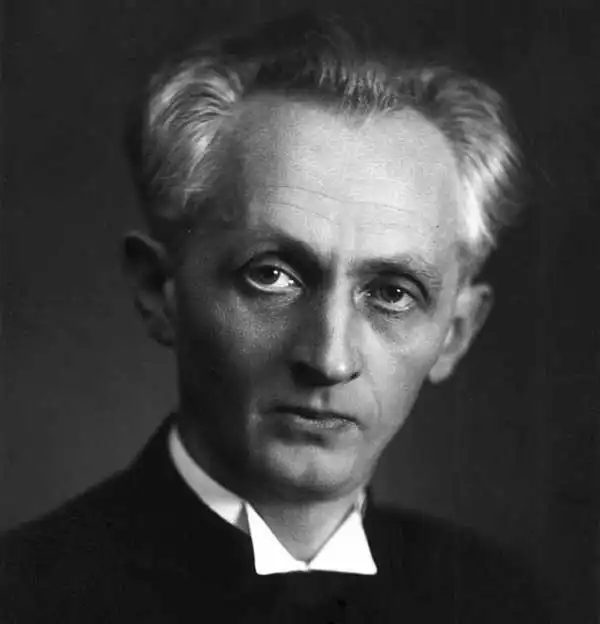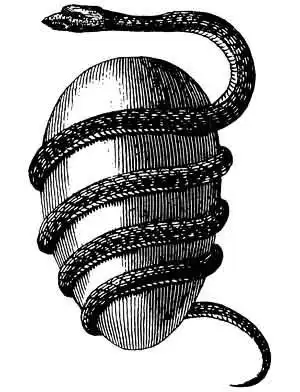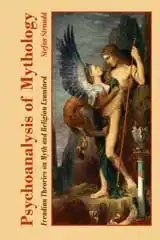Károly Kerényi
His theories about mythology and religion examined by Stefan Stenudd
The main reason for including him here is that he co-wrote a book on that very subject with Carl G. Jung:Einführung in das Wesen der Mythologie (Introduction to the Essence of Mythology) in 1942. It this book they take turns. Kerényi presents mythological themes,mythologems, and Jung adds psychological aspects to them. There are two main themes, the child-god and the Kore. According to Kerényi, the latter is not only Persephone who is usually associated with the name, but the maiden goddess in general. Kore simply means maiden.[1] In spite of their elaborate ways to analyze mythology, Kerényi insists that one does justice to it, “not by interpretation and explanation but above all by letting it alone and allowing it to utter its own meaning.”[2] He adds:
Kerényi’s statement can only be understood symbolically. When gods are born, they must do that as children although it is not mentioned in the myths. He seems to regard it as implied, but that is a weak basis for a theory of the mythological meaning. When discussing Kore, the maiden goddesses, he readily admits that they are “far more typical of Greek religion than boy-gods.”[4] As for Kore, he sees her as a female counterpart to the boy-god, representing the woman’s fate in a budlike form:
Contrary to his co-writer, though, Kerényi is rather reluctant to use the term archetype. He mentions it only three times in passing. To compare, his use of the concept monad, as understood by the ethnologist Leo Frobenius, is much more frequent. He explains the concept:
Primordial imageGenerally in his writing, Kerényi seems hesitant to apply the term archetype — or even to mention Jung. In The Heroes of the Greeks, written more than a decade after the above discussed text, he just mentions Jung once, and that is in the preface. He doesn’t dwell on the archetypes at all, although the hero is the most central of them in Jungian thought.Also in his last book, Zeus and Hera, he mentions Jung once, in the introduction, but the term archetype appears several times, also in the subtitle, Archetypal Image of Father, Husband, and Wife. But that is in the English translation. The German subtitle uses “Urbild” (primordial image) instead of archetype. They are often treated as synonymous, although the word “Archetyp” exists in the German language. Kerényi uses it a few times in the German version of the book. At one instance he connects it to Urbild, and there the English translator chose “prototype” for the German word, which is neither wrong nor optimal. Anyway, while comparing the two words, Kerényi explains why he is reluctant to use archetype: “The Greek word archetypos — from the language of the philosophers — is adjectival and I like to use it substantively only when greater intelligibility can be achieved.”[7] That grammatical condition was respected by the translator in the subtitle, and there are plenty of instances of the adjective archetypal in the text. It is harder to understand the titleAsklepios: Archetypal Image of the Physician’s Existence, since neither archetype nor prototype or anything like it is in the German title:Der Göttliche Arzt. Studien über Asklepios und seine Kultstätte. But Kerényi explains in the preface that he was the one insisting on that translation in the subtitle for this and the other monographs on Greek deities. He did so to “stress the possibility of convergence with modern psychology.”[8] Still, he insists on the previous page that he does not attempt to apply the methods of Jungian psychology. He refers to other writers for that. The word is not used elsewhere in the book. His reluctance to use archetype as a noun separated him distinctly from Jung, who definitely regarded the archetypes as entities in the collective unconscious. Kerényi stayed with the adjective, indicating that he did not agree with Jung on that. What he described with the word was an attribute, and not a thing in itself. To him, then, the father was not an archetype, but some mythological fathers could be archetypal, and the same for the mother, the maiden, and so on. He also allowed for the archetypal significance of a deity to change as its role shifted in the mythology. Jung’s view was much more rigid. In the introduction toEleusis: Archetypal Image of Mother and Daughter Kerényi discusses Jung at some length, and points out that it was not he who turned to Jung, but the opposite. Jung found support for his own theories in Kerényi’s writing.[9] Kerényi is clear about not always agreeing with Jung’s interpretations, for example when it comes to the archetypal:
[1] Carl G. Jung & Károly Kerényi, On a Science of Mythology: The Myth of the Divine Child and the Mysteries of Eleusis , transl. R. F. C. Hull, New York 1949 (originally published in German 1942), p. 147. [2] Ibid., p. 4. [3] Ibid., p. 12. [4] Ibid., p. 148. [5] Ibid., p. 147f. [6] Ibid., p. 26. [7] Károly Kerényi,Zeus and Hera: Archetypal Image of Father, Husband, and Wife , transl. Christopher Holme, Princeton 1975 (originally published in German 1972), p. xii. [8] Károly Kerényi,Asklepios: Archetypal Image of the Physician’s Existence, transl. Ralph Manheim, New York 1959 (originally published in German 1947 and revised in 1956), p. xxvi. [9] Károly Kerényi,Eleusis: Archetypal Image of Mother and Daughter, transl. Ralph Manheim, New York 1967 (originally published in 1960), pp. xxiv ff. [10] Ibid., p. xxxii.
Jungians on Myth and Religion
This text is an excerpt from my book Archetypes of Mythology: Jungian Theories on Myth and Religion Examined from 2022. The excerpt was published on this website in January, 2023.

MYTH
IntroductionCreation Myths: Emergence and MeaningsPsychoanalysis of Myth: Freud and JungJungian Theories on Myth and ReligionArchetypes of Mythology - the bookPsychoanalysis of Mythology - the bookIdeas and LearningCosmos of the AncientsLife Energy EncyclopediaOn my Creation Myths website:
Creation Myths Around the WorldThe Logics of MythTheories through History about Myth and FableGenesis 1: The First Creation of the BibleEnuma Elish, Babylonian CreationThe Paradox of Creation: Rig Veda 10:129Xingu CreationArchetypes in MythAbout CookiesMy Other WebsitesCREATION MYTHSMyths in general and myths of creation in particular.
TAOISMThe wisdom of Taoism and the Tao Te Ching, its ancient source.
LIFE ENERGYAn encyclopedia of life energy concepts around the world.
QI ENERGY EXERCISESQi (also spelled chi or ki) explained, with exercises to increase it.
I CHINGThe ancient Chinese system of divination and free online reading.
TAROTTarot card meanings in divination and a free online spread.
ASTROLOGYThe complete horoscope chart and how to read it.
MY AMAZON PAGE
MY YOUTUBE AIKIDO
MY YOUTUBE ART
MY FACEBOOK
MY INSTAGRAM
MY TWITTER
STENUDD PĹ SVENSKA
|
 Archetypes of Mythology
Archetypes of Mythology Psychoanalysis of Mythology
Psychoanalysis of Mythology